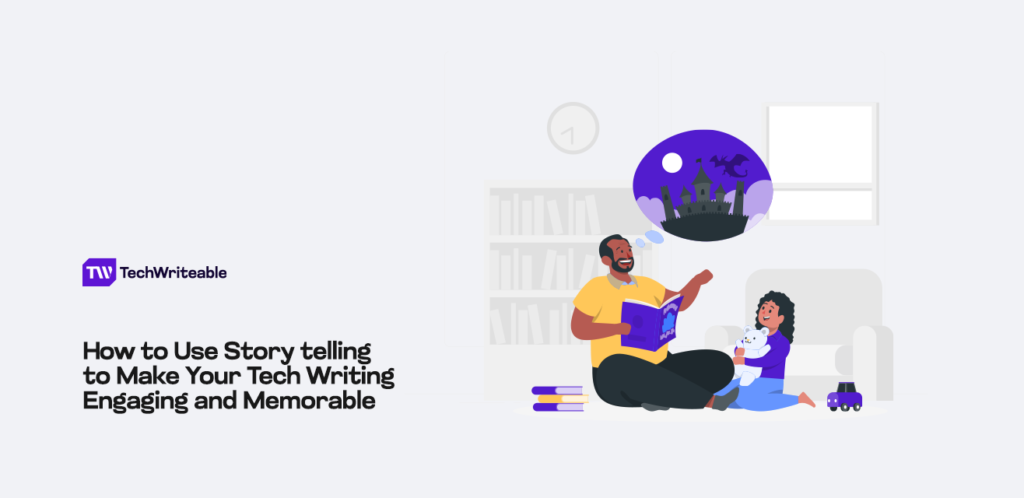Tech writing can be a complex collection of information that only experts can and should be able to decipher, but there is a way for others to understand it. Storytelling is the foundation of all immersive art forms. Tech writing desperately needs storytelling, as it diffuses the complex jargon of the technical space. It establishes a link between those who want to learn about tech products and those who are experts.
This article will serve as a guide to help you know the importance of storytelling in tech writing and how to harness the power of storytelling as a technical writer. Let’s dive in!
What is Storytelling in Technical Writing?
Storytelling in technical writing is like storytelling in every other aspect of writing. It involves sharing experiences and knowledge that further explain or inspire readers and customers to buy into technical concepts.
By sharing stories, you invite others into your unique experiences, allowing them to glimpse what they may find as they use a similar product. Stories are vital in establishing personal connections with readers and customers. They can offer a relatable situation for the manufacturer and writer.
Storytelling engages and helps an audience remember information and make decisions based on the written content. Storytelling affects the much-needed response the content hopes to achieve.
Storytelling is especially compelling because humans respond to the experiences of others. Storytelling in technical writing aims to establish connections. The tech space still requires a bridge to connect it to other concepts. Since stories help establish connections, the easiest way to drop anchor to the rest of the world’s concepts is to tell them.
Why Storytelling is Important
With the advent of AI writing and other machine-generated content, the internet has content that, though relevant to users’ needs, needs to establish the connection needed to prompt a response or action, among other things.
In recent times, through Search Generative Experience, Google has awarded preferential attention to personal content that highlights individual experiences, which helps meet user needs. This new update only bolsters the need for more technical writers to incorporate storytelling in their editorial process.
Here are some of the reasons why storytelling may do more for you as a technical writer than regular marketing tips:
1. Stories Simplify Concepts
The feel of machine-generated content cannot trump the expressive and experiential semblance of human-generated content. It misses the human undertones necessary to hit the nail on the head and satisfy the user’s needs. The tech space is relatively new, and many people are still trying to understand the latest concepts that tech brings. A real-life example can help simplify an abstract idea and make it more relatable to daily life, which fosters understanding.
2. Stories Unite People
It is essential to note that simply relatable stories bind all other ideas to tech. Telling stories is an easy way to get others to understand complex concepts. Stories are a universal language, breaking through barriers and differences and connecting us with feelings.
3. Stories Motivate People
Stories strip away a brand’s glamorous parts, leaving behind its authenticity. They expose a brand’s good and bad parts, tapping into people’s emotions. Stories bring high and mighty brands to the customers’ daily lives, establishing a connection and driving action.
By telling stories, you can overcome a reader’s or customer’s skepticism and allow them to see you through their eyes, which promotes loyalty.
How to Use Storytelling to Make Your Tech Writing Engaging and Memorable
The storytelling process in tech writing must be well-thought-out as there is so much information you intend to pass across to your consumer in one brief story. Every step is pivotal to the general reception of the message. However, the process must begin from somewhere, and we are here to tell you how to start.
1. Identify Your Audience
Marketing is primarily about convincing the demographic that they need your product. To compel the demographic, you need to understand them and who will give a positive response.
In identifying your audience, it is wise to build an audience persona who is a semi-fictional character of who your audience may be. To build an audience persona, you must identify your audience and find who needs your story most.
By understanding who will respond to the story about the product, you can go above and beyond in crafting a story that better resonates with your audience.
You should take the time to research your demographic by age range, gender, and stage of life. You should also consider their emotional and human side, goals, and needs. This will also help you identify their behavioral patterns, the social media channels they engage with, and the content they engage with. It will help you assemble all the data you need to build an audience persona.
A great example of a thorough effort to identify an audience is LEGO’s Mission Impossible. The movie franchise has lasted over 26 years, with more and more generations being indoctrinated into the thrill of undiluted espionage.
What better way to build an audience persona that includes youngsters than by
introducing LEGO’s Mission Impossible Dimensions level pack, which gives fans their fix? An awesome product like Mission Impossible exists, and an audience persona with gamer needs provides an open door for a partnership. The LEGO gaming experience is an opportunity to expand the reach of the Mission Impossible story.
2. Define Your Message
It is essential to understand that the core of your message is like the foundation of a building. Knowing the message you want to convey in your story is pivotal to the response you will receive.
Consider whether your story incites action to buy a product, convey values, or educate your readers or listeners. Are you advocating for an issue, or are you trying to earn loyalty from those who will come in contact with your story?
All these are valid questions to ask in the storytelling process. They will help guide your message and influence the kind of story you will tell.
3. Choose Your Story Medium
Your story can take various forms depending on the type of audience you have. Many are avid readers, and writing is a particularly expressive form of storytelling.
Written stories are a budget-friendly method of storytelling, as they require simple document tools or even a pen and paper and your creativity.
4. Structure
Now that you know who you are crafting your story for, it’s time to plan and structure your content. If you use a writing medium, now is a great time to create an outline. Every step, from the start intro to the call to action, is essential to bolster the point correctly.
In storytelling, you must ensure that your story is engaging and imaginative and sparks emotion when you share it. Create a detailed outline to help you stay focused as you create your story. You can use storyboards, PowerPoint, or any other tool to help arrange your thought process and keep you on track.
To create a proper structure for your story, it must follow the three-act structure: Setup, Climax, and Resolution. These three levels form the perfect structure and summary for a story.
The setup will focus on the beginnings, where the main characters are presented and the plot is laid out. The climax is the dramatic build-up of the story that should quicken or evoke your audience’s emotions. It is where you set everything in motion to get your audience to perform whatever action you require.
Finally, your resolution should encompass everything that your climax could and could not agree on. It is meant to help you prepare your audience to take action.
5. Create Your Story and Include Your CTA
Now, it is time for you to craft your story correctly and add the details that concisely combine your thoughts and message. Following your outline, you can draft a story that your consumers will receive and that will motivate them to take the requisite action.
Your call-to-action (CTA) should clearly state the action you want your audience to take after reading, watching, or listening to your content. After your audience consumes your content, what do you want them to do? Do you want them to leave a review? Buy a product? Or subscribe to your newsletter?
Take, for instance, LEGO’s 90th-anniversary advert; the story centers on how vital building is to daily living, even if it is with LEGO bricks. Ultimately, it gives a solid call to action: to ‘Keep building.’ Notice that the entire story has one key demographic before your eyes: children.
For a child who sees this advert, it is a wake-up call to do something impactful and make the world a better place with a playful object like LEGOs. The call-to-action establishes one thing – buying LEGOs because this is the only way kids can ‘keep building’.
6. Share Your Story
After your story is complete, the only thing left is sharing it. Like every other marketing copy, creating is just one part of it. Sharing your story is the last step in ensuring your audience gets to interact with it. There are several ways you can share your story for maximum reach. You can choose email, one of the most leveraged channels for sharing.
You can share your written story on blogs such as Medium or resort to guest posting on other publications. Video stories, especially short-form videos, take the grand prize for the highest ROI generated. The more places or platforms you share your story, the more engagements and actions you can expect from them.
Wrapping Up
Storytelling is an essential part of technical writing that helps bridge the gap between tech enthusiasts and tech writers.
It is important to note that following the step-by-step guide will help optimize storytelling efforts and create concise and evocative stories that achieve the desired objective. The guide will meet your needs whether you want consumers to buy a product, support a movement, or join a community.
You can learn more about SaaS tools and productivity hacks that make tech writing easier and more engaging by logging on to the TechWriteable blog for more content.



